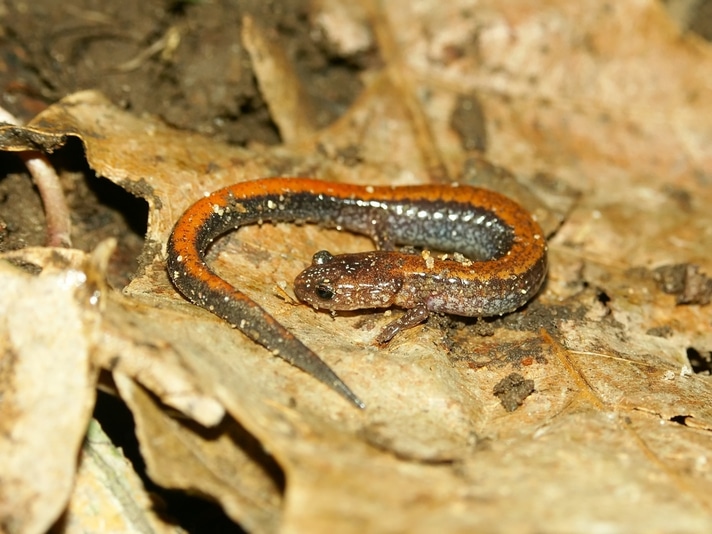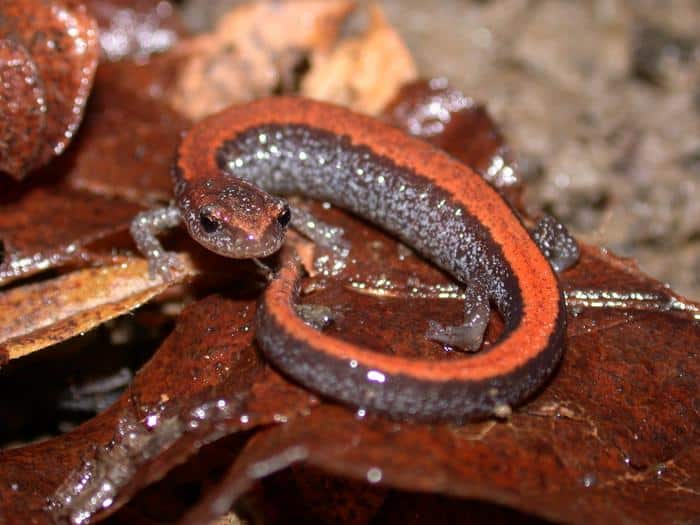The researchers estimate that there are about 5,300 salamanders in every football field-sized patch of forest in the northeastern United States
The United States Geological Survey has found that the red-backed salamander is abundant in forests of the northeastern United States. The study, confirmed what the scientists already knew, that they were abundant, but what they didn’t know was what their densities and biomass were across the region.
“The very large biomass of red-backed salamanders tells us that they are likely ‘small but mighty’ in terms of their role in the ecological health of northeastern forests,” said Evan Grant, lead author and USGS research wildlife biologist. “If red-backed salamanders disappeared, there would probably be some pretty large ecosystem-level consequences.”
The researchers estimate that there are about 5,300 salamanders in every football field-sized patch of forest in the northeastern United States. This gives them some of the highest biomass in the forest for animals other than insects and “similar or greater than the white-tailed deer.”

Jason Patrick Ross/Shutterstock
The study, “Range-wide Salamander Densities Reveal a Key Component of Terrestrial Vertebrate Biomass in Eastern North American Forests,” marks the first instance in which the biomass and densities of the amphibian was calculated across its range.
Salamander Densities and Bsal
The study is notable in that it dovetails with another study that says that proactive management of wild populations against Batrachochytrium salamandrivorans, or Bsal, a fungal disease which has decimated wild salamander populations in Europe, is far more beneficial than reactive management. Bsal has not yet been detected in the United States.
Interim Ban Placed On Importation And Interstate Transport Of 201 Salamander Species
The second study, “Proactive management outperforms reactive actions for wildlife disease control,” relied on computer modeling to determine that managing wild populations of salamanders before Bsal is detected in the United States will be more successful in protecting the wild populations than taking a reactive approach (waiting for the onslaught of the fungus or doing nothing at all).
“If we do nothing to manage Bsal, the model forecasted that the disease would be catastrophic to North American salamander species,” Molly Bletz, assistant professor of disease ecology at Penn State and lead author of the second study said in the statement “This study gives strong quantitative support to proactive management actions. Basically, if we want these at-risk salamander species to be around in the future, doing something proactively is our best bet.”
The study authors suggest that the following proactive management techniques can help curtail Bsal if and when it reaches the United States:
- making it harder for amphibians to spread the disease amongst themselves through installing barriers or increasing habitat complexity;
- reducing Bsal fungal spores in aquatic habitats by temporarily raising the water temperatures, increasing the salinity, or increasing the abundance of zooplankton that consume funguses;
- helping amphibians fight off the disease by improving their health through supplemental feeding, etc., increasing the abundance of local, beneficial anti-fungal microbes, or through vaccination.
An abstract of the study, “Range-wide salamander densities reveal a key component of terrestrial vertebrate biomass in eastern North American forests” can be read on the Biology Letters website.
The complete study, “Quantitative support for the benefits of proactive management for wildlife disease control” can be read on the Conservation Biology website.
About Bsal
Bsal is a chytrid fungus that caused salamander die offs in Europe. While the pathogen is currently not known to exist in the United States, it has decimated black-and-yellow spotted fire salamanders (Salamandra salamandra) in much of Europe. The fungus can kill salamanders in as little as four days.
The fungus causes tumors and skin ulcers on infected salamanders, which compromises the amphibian’s immunity to other disease. It spreads rapidly and is known to spread through the air, soil and water and is also carried by birds and frogs, as well as newts, toads and other amphibians. The fungus is considered to be more lethal than chytrid fungus, which is present in the United States and affects frogs and toads.
Researchers believe the fungus originated in Asia, where salamanders there are immune to it. It is said to have spread to Europe through the forestry, agricultural and wildlife trade.
About the Red-backed Salamander
The red-backed salamander is known to inhabit forested areas under rocks, as well as in forest floor leaf litter and debris. It grows to about 2 to 4 inches in length and feeds on mostly small insects, millipedes, centipedes, spiders, gastropods and pseudoscorpions.


